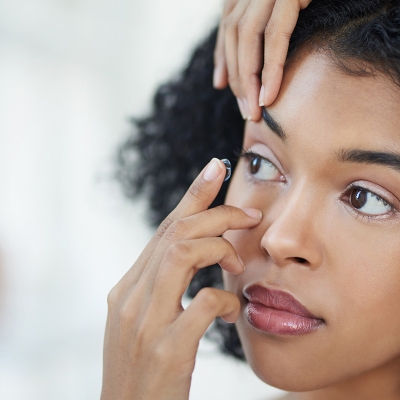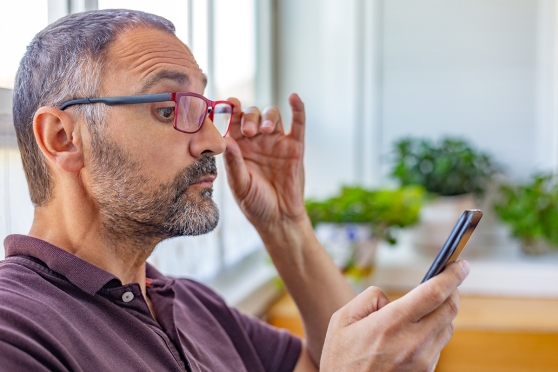5 simple ways to lower blood sugar (that may help with eyesight)
Diabetes can lead to eye disease. But learning strategies to manage blood sugar levels could help save vision. Here’s how.

For people who have diabetes, managing blood sugar (glucose) is important for their health and their eyes. That’s because having chronically high blood sugar may damage the tiny blood vessels in the eye over time, and that could lead to eye diseases.
One eye disease that may affect people with diabetes is diabetic retinopathy. That’s when the blood vessels in the retina, the light-sensitive layer of tissue at the back of the eyeball, leak blood and fluid. That can lead to blurry vision and vision loss.1
Another condition that may affect people with diabetes is called diabetic macular edema. That’s when fluid builds up within the eye. People with diabetes also have higher odds of developing cataracts earlier, as well as glaucoma. Both conditions may lead to blindness.2
Diabetic retinopathy and diabetic macular edema are both common in people with diabetes. For instance, about one-quarter of people with diabetes have diabetic retinopathy. That’s about 10 million people, according to the most recent data.3
Blood sugar may affect the eyes in another way too. When blood sugar levels are very high, it may affect the shape of the eye lens, which could lead to blurry vision. When blood sugar levels are under control, the blurriness usually goes away.1, 4
If someone has diabetes, it’s a good idea to connect with a health care team to figure out a plan to manage and lower blood sugar. A registered dietitian who works with diabetes patients can often be a great resource, as can an eye care provider. Also, eye care providers can test how well people are managing their diabetes by giving them an eye exam, and help people maintain healthy vision.
Read on to find out 5 simple ways to better manage blood sugar levels — and see better in the process.
Stay on top of your eye health with an in-network provider. Search for an eye care provider now.
1. Manage carb consumption.
One of the biggest myths about people with diabetes may be that they can’t eat any carbohydrates. “This is simply not true,” says Sherri Nordstrom Stastny, Ph.D., R.D. She’s a professor in the department of health, nutrition and exercise sciences at North Dakota State University. To help prevent blood sugar spikes, she advises consuming complex carbohydrates at each meal. These include whole grains or whole foods such as:
- Apples
- Sweet potatoes
- Whole wheat pasta
These types of food are high in fiber, which aids in slowing down digestion.5 That may allow glucose to enter the bloodstream at a steadier rate.
High-fiber foods include:
- Beans and lentils
- Fruits
- Nuts and seeds
- Vegetables
- Whole grains
“Aim to eat foods in their more natural form. Think about eating a whole apple versus drinking apple juice,” says Stastny.
2. Add some healthy fat.
Not all high-fat foods may be harmful. Those that contain healthy, unsaturated fats may be good for people with diabetes. “Fat is important for helping control blood sugar because it doesn’t break down as fast as some carbohydrates,” says Stastny.
Healthy fats may include:
- Almonds and cashews, as well as nut butter (without added sugar)
- Avocado
- Olive and canola oil
- Sunflower and chia seeds
All these foods may provide heart-healthy unsaturated fat that slows digestion and results in a lower rise of blood glucose, explains Stastny. Keep in mind that these foods do typically contain more calories. So it may be a good idea for people to eat them in moderation.
3. Stay hydrated.
Sipping fluids regularly may be important for diabetes management. When people get dehydrated, sugar in the bloodstream becomes more concentrated. That may trigger an overall rise in blood sugar.6 Water is also calorie- and sugar-free, making it a smart sip.
However, staying hydrated doesn’t mean drinking beverages that contain a lot of added sugar, notes Stastny. One of the biggest culprits in terms of high blood glucose may be sugary coffee drinks. “This adds a lot of sugar and saturated fat to the daily diet of someone with diabetes,” she says.
Rather than giving up these beverages though, consider finding ways to decrease the sugar and fat, notes Stastny. Here are some helpful strategies:
- For someone who regularly adds 2 tablespoons of flavored creamer to their coffee, cut back to 1 tablespoon.
- Ask for sugar-free syrup at a coffee shop and request half the number of pumps.
- Add a sprinkle of cinnamon to coffee, which adds sweetness without the sugar.
4. Get out there and move.
Being active may be key for people with diabetes. Here’s why: Exercise causes the muscle cells to use blood sugar for energy. Physical activity may also help improve insulin sensitivity. Both may help lower and manage blood sugar levels.7
“People are typically too sedentary, but it’s important to work exercise into our lives more often,” says Stastny. A good goal may be aiming for 20 to 25 minutes of physical activity a day.8 Some fun activities may include:
- Grabbing a friend, partner or family member for a power walk around the neighborhood
- Dancing in the kitchen while making dinner
- Heading to the local pool for a quick swim
- Playing tag or some other type of active game in the backyard
Stastny is a huge fan of “fidgeting,” or getting up and moving around more. That includes walking around during a commercial break when watching TV. That could also include walking to the kitchen or water cooler to refill a water bottle during the workday.
5. Get enough shut-eye.
It’s recommended that adults get at least 7 hours of sleep per night.9 It’s a good idea for people with diabetes to try to get that amount most nights. That’s because sleep may affect diabetes in several ways:10
- Too little sleep may increase insulin resistance, which may affect blood sugar levels.
- Too little sleep may affect how hungry you are the next day, and people who are hungry are more likely to reach for junk food or sugary snacks to keep up their energy. These foods also tend to raise blood sugar, or lead to glucose spikes.
Managing blood sugar is key for people with diabetes. And, in turn, it may help lower their risk of eye diseases. After all, eyesight and health are both precious. So keep up with regular eye appointments and renew prescriptions for eyewear as needed.
Need new glasses? In 3 easy steps, you could have a new pair on the way. Check your vision coverage, select your favorite frames, then check out. Done!
Sources:
- Diabetes and vision loss Centers for Disease Control and Prevention, last reviewed December 2022.
- Diabetic eye disease resources National Eye Institute, last updated February 2023.
- Prevalence of diabetic retinopathy in the U.S. in 2021 JAMA Ophthalmology, June 2023.
- Diabetes symptoms: When diabetes symptoms are a concern Mayo Clinic, June 2023.
- Fiber: The carb that helps you manage diabetes Centers for Disease Control and Prevention, Last reviewed June 2022.
- Sports drinks impact on glucose (blood sugar) American Diabetes Association.
- Blood glucose and exercise American Diabetes Association.
- Get active! Centers for Disease Control and Prevention, last reviewed November 2022.
- Are you getting enough sleep? Centers for Disease Control and Prevention, last reviewed September 2022.
- Sleep for a good cause Centers for Disease Control and Prevention, last reviewed July 2022.


